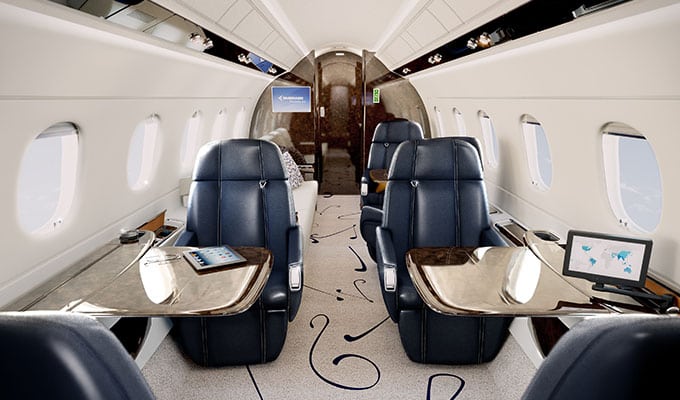[Avionics Today 09-26-2014] The last 10 years have seen dramatic economic growth for Latin America, Mexico and the Caribbean. Flourishing in tandem with the rise in industry and business is, of course, the need for business jets.
 |
|  Cabin of Embraer Legacy 500 business jet. Photo: Embraer |
“There is certainly an improvement in the Latin American business jet market. Recent sales results have produced a steep growth in Latin America’s share of the global fleet, reflecting the growing economic strength of the region,” said Marco Tulio Pellegrini, president and CEO of Embraer Executive Jets.
The previously unimpressive business jet market in Latin America is not only alive and well, but has been taking off dramatically as markets such as oil and telecommunications take hold and spread throughout the region. While Pellegrini notes the business jet market is seeing particular patronage from “ultra-high-net-worth individuals worldwide,” aviation consultant Rolland Vincent of Rolland Vincent Associates believes that more widespread wealth and industry are responsible for the budding economy.
“I think most of it is the accumulation of wealth [and] high-net-worth individuals; the growth of that community has been pretty dramatic in that part of the world. Latin America has a strong resource-based economy, but more and more we see manufacturing and service related growth, telecoms, oil and gas extraction,” Vincent said, noting that even just transporting shipments to and from larger facilities creates industry and drive all sorts of economic expansion.
And this expansion, whatever the reason, runs parallel to the rise in the need for business aviation.
“In the last 10 years, the growth of [Gross Domestic Product] GDP and the growth of the fleet in Latin America — in which we include Mexico and the Caribbean — has been pretty much equal. As the fleet has grown, GDP has grown, by just around 4 percent on average per year,” Vincent said.
The growth, however, isn’t spread equally across all countries. According to Pelligrini, Brazil and Mexico are seeing most of the development in the business aviation industry.
“Much of this regional growth has been driven by continued demand for our aircraft in Brazil and Mexico, which are home to the world’s third and second largest business aviation fleets, respectively. Demand outside Brazil and Mexico is lower, accounting for only 17 percent of the region’s deliveries in five years, from 2009 to 2013,” Pelligrini said. “Together, these two countries will account for the shipments of nearly 700 jets in the next 10 years, with Brazil being responsible for more than 75 percent of this total.”
And Vincent notes that most of this rise in orders serves internal demand. Operators report that 79 percent of operators who take off in the region land there as well, according to Vincent, with only 29 percent of flights landing in North America and the other 1 percent landing in Europe, pointing to a flourishing regional economy that’s not relying on foreign business.
So what are these operators flying? Vincent notes that Embraer, located in Brazil, is particularly popular among operators in the region, calling them “almost evangelical” about their passion for the locally based aircraft manufacturer. It comes as no surprise then, that the new Legacy 500 — which recently entered into service at the Latin American Business Aviation Conference and Exhibition (LABACE) in August — and other Legacy aircraft are causing quite a stir.
“The Legacy 600, Legacy 650 and Lineage 1000E have become established favorites for the transcontinental and intercontinental travel demanded of a large global economy such as Brazil’s,” Pelligrini said.
But with such a quick rise in demand, the availability of infrastructure to support it is a concern for operators and manufacturers alike.
“Lack of infrastructure is absolutely the biggest problem,” Vincent admitted. “There’s a lack of airways, airports, [Fixed-Based Operators] FBOs, [Maintenance Repair and Overhaul facilities] MROs, even technical talent. It’s still very early days.”
However, there’s quite a push to bolster this infrastructure and mounting pressure to provide new airports, hangars and facilities. Embraer is attempting to meet this demand by vastly expanding facilities already in place as well as adding new facilities to the region, such as Embraer’s new Service Center in Sorocaba, Brazil just west of São Paulo.
“This facility has two hangars: one dedicated to maintenance, repair and overhaul of our executive jets. The other, an FBO to support the operation of business aircraft with a passenger boarding and arrival terminal, airport services, meeting rooms for customers and rest areas for crew members,” Pelligrini said, who also noted the expansion of many other Embraer facilities throughout Latin America and Mexico.
This is all good news for the avionics market where a shooting demand means opportunities for not only new avionics systems, but MRO as well as many operators turn to upgrade an aging fleet.
“The world of avionics has dramatically transformed, manufacturers have adopted some of the latest and greatest technology to help make these aircraft more useful tools,” Vincent said.